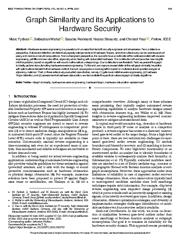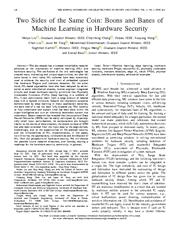A copy of this work was available on the public web and has been preserved in the Wayback Machine. The capture dates from 2020; you can also visit the original URL.
The file type is application/pdf.
Filters
Graph Similarity and Its Applications to Hardware Security
2019
IEEE transactions on computers
Third, in three extensively evaluated case studies, namely (1) gate-level netlist reverse engineering, (2) hardware Trojan detection, and (3) assessment of hardware obfuscation, we demonstrate the practical ...
From a defensive perspective, it allows for detection of intellectual property infringements and hardware Trojans, while it simultaneously can be used for product piracy and malicious circuit manipulations ...
Science Foundation (NSF) award CNS-1563829, by the German Federal Ministry of Education and Research (BMBF Grant 16KIS0820 emproof and MED4D, part project 05M16PCA). ...
doi:10.1109/tc.2019.2953752
fatcat:g4aye6r77rbdvoyuwwpnxsa3pq
Two Sides of the Same Coin: Boons and Banes of Machine Learning in Hardware Security
2021
IEEE Journal on Emerging and Selected Topics in Circuits and Systems
ML schemes have been extensively used to enhance the security and trust of embedded systems like hardware Trojans and malware detection. ...
On the other hand, ML-based approaches have also been adopted by adversaries to assist side-channel attacks, reverse engineer integrated circuits and break hardware security primitives like Physically ...
Controllability and Observability for hardware Trojan Detection (COTD) [89] uses unsupervised k-means clustering to isolate Trojan signals based on the controllability and observability analysis of gate-level ...
doi:10.1109/jetcas.2021.3084400
fatcat:c4wdkghpo5fwbhvkekaysnahzm


